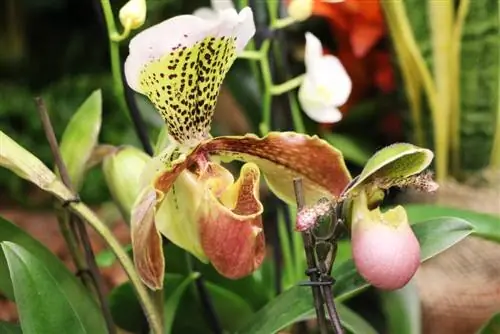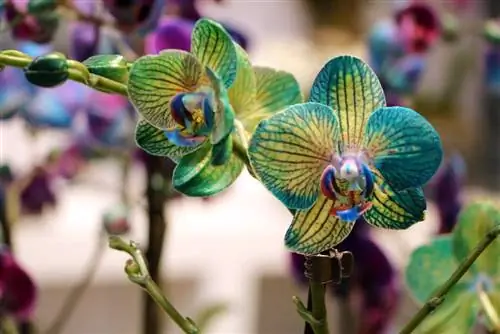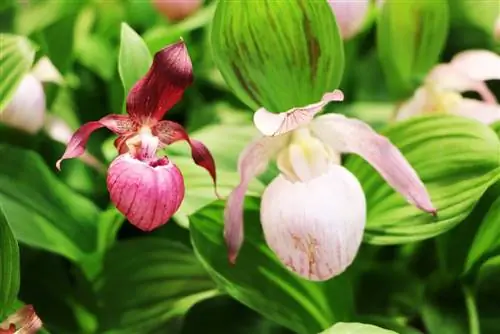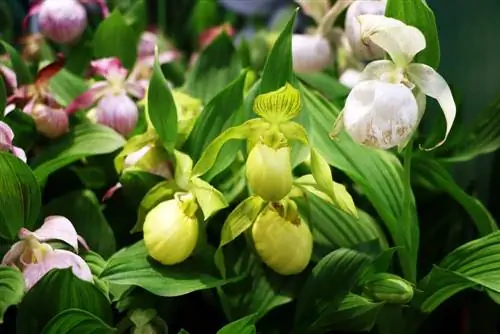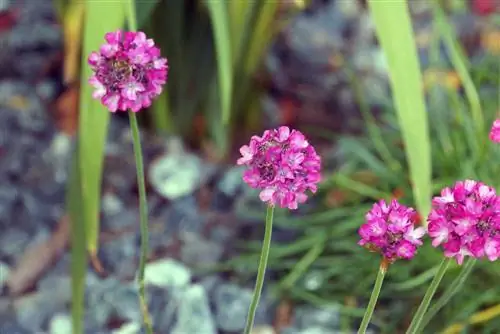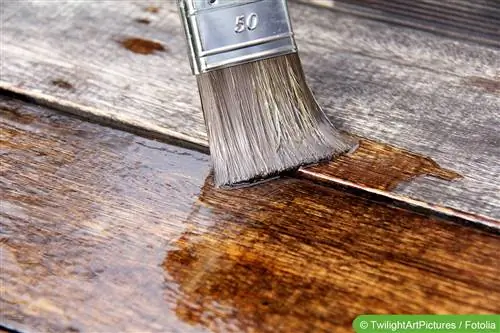- Author admin [email protected].
- Public 2023-12-17 03:39.
- Last modified 2025-01-24 12:45.
The different types of garden orchids sometimes have very different requirements in terms of their location, soil and care. This is why maintenance errors often occur, which can turn a culture into a failure. As a rule, hybrids are more tolerant than natural species (wild species). It is best to buy outdoor orchids from specialist retailers. Here the plants are not only optimally prepared, but important care instructions and site conditions are also given, which can prove to be very helpful in cultivation.
Species
Orchids are not only found in the tropics. A variety also grows in our latitudes. Some species are native to mountains or very calcareous soils, others prefer moist meadows near streams or even moors. In the following list, at the beginning there are the more robust garden orchids, which are more suitable for beginners, as the outdoor orchids go down, they become increasingly more sensitive.
Gymnadenia (Handelwort)
Some species of the outdoor orchid Gymnadenia are also native to us and can be described as hardy. Overall, this garden orchid is one of the easier to care for and tolerant specimens and is therefore well suited for beginners. A flower stem usually consists of many (up to 50) small individual flowers with a characteristic orchid flower shape.
- Location: partially shaded, can also tolerate full sun locations with appropriate soil moisture
- Soil: well drained, otherwise very tolerant
- grows on almost any normal garden soil, preferably sandy or calcareous
- Fertilizing: do not fertilize on humus-rich soils, otherwise once a month
- Growth height: 30-65 centimeters
- usually frost hardy
- cover with bark mulch in winter
- robust varieties: Gymnadenia conopsea, Gymnadenia odoratissima
Genus Bletilla (Japanese orchid)
One of the most beautiful genera of garden orchids is the Bletilla. It originally comes from Asia (China, Japan) and is known as an outdoor orchid that is quite easy to cultivate. Bletilla is characterized by wonderfully delicate flowers in different colors. Some hybrids even tolerate frosts down to minus thirty degrees.
- Location: partially shaded, no midday sun
- Soil: quite soil-tolerant, neutral or slightly calcareous
- Substrate: Mixture of humus soil, sand, pieces of bark
- Growth height: 20-30 centimeters
- some species extremely cold-resistant (-30 degrees)
- no special winter protection necessary
- Protect against moisture in winter (bark mulch, stretch foil if necessary)
- multiplies on its own with good care and forms colonies
- robust varieties: Bletilla striata and Bletilla formosana
Calanthe
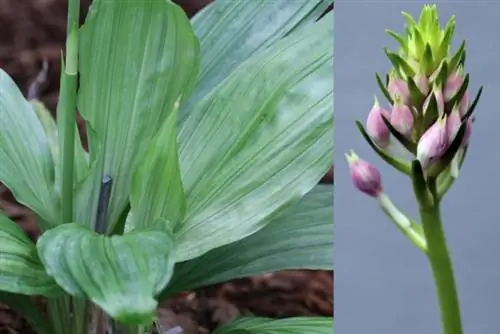
Although the Calanthe is actually native to the tropical areas of Asia, Central America and Africa, breeders have now created a number of varieties that are also suitable for outdoor cultivation.
- Location: partially shaded
- Soil: well-drained, slightly acidic
- hardy to around -10 degrees
- do not fertilize
- robust species: Calanthe discolor, Calanthe kozu hybrid, Calanthe reflexa
Genus Epipactis (Stendelwort, Marshroot)
The location conditions of the orchid, some of which are native to us, are very different. While species such as Epipactis helleborine (broad-leaved pendelwort) are primarily native to the deciduous forests of Europe and Asia, but also on forest edges and clearings, Epipactis palustris (swamp pendelwort) grow in very wet areas and can tolerate a little more sun and also acidic soils.
- Location: sunny to partially shaded
- Epipactis gigantea: calcareous soils
- Epipactis helleborine: neutral soils, but very tolerant
- Epipactis palustris: acidic to neutral soils
- Substrate: higher proportion of humus possible, well permeable to water
- Growth height: 20-100 centimeters
- many species have good frost resistance
- very easy to grow in good location conditions
- a root barrier is necessary for some varieties
- Most common species: Epipactis helleborine, gigantia and palustris
Pleione (mountain orchid)
The mountain or Tibetan orchid only occurs in a few species in nature, but countless hybrids of the pretty garden orchids have been bred. The orchids originally come from monsoon regions in Southeast Asia. The variety of different flower colors is considerable.
- Location: sunny to partially shaded
- Soil: lime-free and well-drained, humus
- Flowering: some varieties in spring, others in autumn
- Early flowering species are generally not frost hardy (except Pleione limprichtii)
- somewhat critical during long, wet periods in winter (rotting)
- need a little more nutrients
- fertilize very diluted every 3-4 weeks (between April and the end of July)
- cover with pine needles or peat in winter
- occasionally add a few horn shavings in addition to liquid fertilizer
- robust varieties: Pleione formosana, Pleione limprichtii
Dactylorhiza (orchid, cinquefoil)
The genus Dactylorhiza includes about 40 different species and occurs in temperate zones of Europe, Asia and North Africa. The racemose inflorescence of the garden orchid is usually much more densely covered with flowers than in the other genera.
- Location: partially shaded, many species also tolerate full sun locations
- Soil: sandy, pH 6-7, low nutrient content
- well permeable to water, both moist and rather dry locations possible
- can also be found in nature in dry grass, on dunes or in swamps
- Growth height: 60-70 centimeters
- Fertilize: in nutrient-poor soils every 14 days with diluted orchid fertilizer (during flowering)
- work a little compost or horn shavings into the soil in spring
- robust species: Dactylorhiza fuchsii and purpurella
Lady's slipper (Cypripedium, Phragmipedium)

One of the most striking orchid species, which is almost exclusively native to temperate latitudes with cool winters, is the genus Cypripedium. Of the almost 60 known species and varieties, as well as around 200 hybrids, many have good frost tolerance. What they all have in common is the characteristic, shoe-shaped petal, which is usually colored in a striking light yellow. However, the lady's slipper is one of the sensitive garden orchids that only grows under optimal conditions and care conditions.
- Location: partially shaded to shady (not too dark)
- Soil: well-drained, rather calcareous
- Growth height: 15-60 centimeters
- Fertilizing: only very cautiously during flowering, lime the soil regularly
- very sensitive to high s alt and nutrient levels in the soil
- During flowering, fertilize frequently with a low concentration (1/5 of the normal concentration of orchid fertilizer)
- robust varieties: Gisela, Michael, Ulla Silkiens, Cypripedium formosanum
General care tips
Garden orchids are a little more complex in terms of their location, soil and care than other bedding or garden plants. They need a soil that allows rainwater to drain off easily, but can also store it, because the substrate for outdoor orchids must never really dry out. However, they react promptly to waterlogging with root rot. A substrate made of garden soil, sand and granules is therefore best suited. To better retain moisture in the soil, we recommend applying a layer of bark humus.
Conditions applicable to all species:
- Location: partially shaded
- high humidity
- moderate exposure to sunlight is a must (never midday sun)
- Planting on the north side of a light, leafy tree (shrub) is optimal
- Protection from heavy rain, hail and strong gusts of wind
- do not plant under a tree or bush (must receive light from vertically above)
- Leave the soil untreated if possible (do not rake)
- Soil: Addition of Seramis, lava granules and sand, pH neutral (6, 5)
- additionally: wood fibers or coconut fibers
- do not fertilize with compost
- Fertilizing: it's better to have too little than too much, spring and summer with diluted orchid fertilizer
- Do not fertilize at all in the first few years, then every 4-6 weeks
- Never allow the soil to dry out, do not create waterlogging
Tip:
To control soil moisture, a watering stick (such as for Seramis hydroponics) can be used in coarse-grained substrate.
Companion plants
Companion plants are an indispensable part of every orchid bed in the garden, but they must be selected very carefully. When it comes to the requirements for soil, moisture and much more, they must suit the orchids and must not overgrow them or hinder their root growth. These companion plants fulfill the following tasks:
- Shading the ground
- Elimination of unnecessary nutrients
- Increase in humidity
Tip:
Slow-growing plants that spread like clumps and do not grow too high are particularly suitable for this. These include small hosts (hostas), lye flowers (Cotula, Leptinella), small striped ferns, dwarf columbines or forest anemones.
Recognizing deficiency symptoms
Garden orchids rarely or never need to be fertilized. Nevertheless, deficiency symptoms can occur in one soil or another:
- Nitrogen deficiency: yellowish, pale leaves
- Phosphorus deficiency: brownish-purple leaves, poorly developed roots
- Potassium deficiency: brown edges on the leaves
- Lack of lime: shoot tips and leaf edges dry up
- Iron deficiency: yellow leaves with green veins
Buy garden orchids
It goes without saying that no wild plants may be dug up from nature when cultivating orchids in your own garden. This is not only punishable because most specimens are protected, but it is also often crowned with failure because either the sensitive roots are damaged or the plant cannot cope with the change in substrate. The best chance of successful cultivation is achieved by purchasing bred hybrids, which can be purchased from appropriately specialized breeders or dealers. When buying, make sure you buy a variety that is frost hardy.

